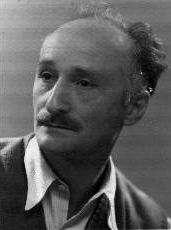Alexander Bogen
| Alexander Bogen | |
|---|---|

Alexander Bogen
|
|
| Born |
Alexander Katzenbogen January 24, 1916 Tartu, Estonia |
| Died | October 20, 2010 (aged 94) Tel Aviv, Israel |
| Nationality | Polish-Israeli |
| Education | Academie des Beaux Arts |
| Known for | Painting, Sculpture, Book Illustration and for being a partisan through the Holocaust |
| Notable work | Apocalipse |
| Movement | Social Realism, Lyrical Abstraction, Abstract Expressionism, Tachisme |
Alexander Bogen (Hebrew: אלכסנדר בוגן; born January 24, 1916 – October 20, 2010) was a Polish-Israeli artist, painter, sculptor, stage designer, book illustrator and a commander partisan during World War II.
Alexander Bogen was born in Tartu, Estonia and brought up in Wilno. As a young boy he adhered to the values of the Yiddish culture of Yung Vilne, as well as to the modern Polish culture. After completing his studies at the gymnasium, he was accepted to the Stefan Batory art academy affiliated with the Wilno University, where he studied painting and sculpture. His parents were physicians. His father came from a secular family and his mother was the daughter of Rabbi Tuvia Lobitzki, the rabbi of Wołkowysk, Poland. His studies were interrupted by World War II. Bogen joined the partisans and became a commander of the partisan unit in the Narocz Forests. He buried many of the drawings he made at this time near Lake Narocz. He returned to the ghetto in September 1943 and helped to facilitate the rescue of members of the United Partisan Organization (FPO), a Jewish underground movement active in the ghetto.
After the war Bogen returned to his studies, finished his academic degree and was mastered as an artist of monumental painting at the USB Academy of Art in Vilna. In 1947, he taught as a professor at The Academy of Fine Arts In Łódź and became a well-known artist, set designer and book illustrator.
...
Wikipedia
